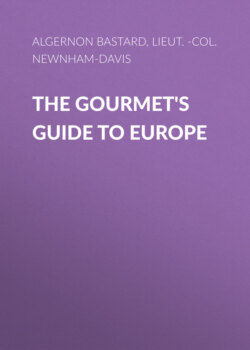Читать книгу The Gourmet's Guide to Europe - Lieut.-Col. Newnham-Davis - Страница 7
На сайте Литреса книга снята с продажи.
Summer Restaurants
ОглавлениеOf the restaurants in the Champs Elysées, Laurent's and Paillard's are the most aristocratic. At Laurent's I generally find in summer some of the younger members of the staffs of the Embassies breakfasting under the trees behind the hedge which shuts the restaurant off from the bustle of Paris outside. Of the special dishes of the house the Canard Pompéienne remains to me an especially grateful memory. It is a cold duck stuffed with most of the rich edible things of this world, foie gras predominating, and it is covered with designs in red and black on a white ground.
Paillard's bonbonnière, in the Champs Elysées, is in the hands of the company which also owns Maire's Restaurant, to which I have already alluded. M. Paillard and the company formed under his name settled a disagreement in the law courts, with the result that M. Paillard retained the restaurant at the corner of the Chaussée d'Antin as his property, and the company took possession of the Restaurant Maire and the Pavillion des Champs Elysées. This, however, is mere history, for the Pavillion serves its meals with all the quiet luxury of the parent house, and I have a memory of a Potage Crème d'Antin which was especially excellent.
Ledoyen's has attained a particular celebrity as the restaurant where every one lunches on the vernissage day of the Salon. At dinner-time, on a fine evening, every table on the stretch of gravel before the little villa is occupied, and the good bourgeois, the little clerk taking his wife and mother-in-law out to dinner, are just as much in evidence, and more so, than the "smarter" classes of Parisians. The service is rather haphazard on a crowded night, and scurrying waiters appeal to the carvers in pathetic tones to wheel the moving tables on which the joints are kept hot up to their particular tables. The food is good, but not always served as hot as it should be—the fault of all open-air dining places. The wine-list is a good one, and I have drunk at Ledoyen's excellent champagne of the good brands and the great years at a comparatively small price. Guillemin, who was cook to the Duc de Vincennes, brought Ledoyen's into great favour in the fifties of the last century.
The Bouillon Riche, just behind the Alcazar, with its girl waiters I have generally found even more haphazard than Ledoyen's. Its food is neither noticeably good nor is it indifferent.
The Ambassadeurs prides itself on being quite a first-class restaurant, and it is one of the special experiences of the foreigner in Paris to dine at one of the tables in the balcony looking towards the stage, and to listen to the concert while you drink your coffee and sip your fine champagne. I have kept the menu of one such dinner, very well cooked and well served in spite of the crowded balcony and general hubbub of the evening, on a Grand Prix night. What the amount of the bill was that the host of the party had to pay I did not inquire, but I feel sure that it was a very long one.
This is the menu:—
Melon.
Potage Ambassadeurs.
Hors-d'œuvre.
Truite Gelée Mâconnaise.
Ris de Veau Financière.
Demi-Vierge en Chaud-Froid.
Poulets de Grain Rôtis.
Salade de Romaine.
Asperges Froides.
Coupes Jacques.
Dessert.
Petites Fraises.
The cold trout was excellent, and the wine was De St-Marceaux '89.
The Alcazar has a restaurant somewhat similar to that of the Ambassadeurs.
Chevillard's, at the Rond Point des Champs Elysées, is not an out-of-doors restaurant, but it is a favourite place to breakfast at on the way out to the races. The cooking is good. Sometimes the restaurant is crowded, and it is as well to secure a table in advance.
There are half-a-dozen cafés, farms where milk is sold, and other refreshment places in the Bois; but the two restaurants which the travelling gourmet is likely to dine at are the Pavillion d'Armenonville and the Château de Madrid. The first is very "smart," and the glass shelter which runs round the little house is filled on a summer night with men, all in dress-clothes, and ladies in flowered or feathered hats. The world and the half-world dine at adjacent tables, and neither section of Paris objects. The tables are decorated with flowers, and two bands, which play alternately, make music so softly that it does not interfere with conversation. The cooking is good, and the prices are rather high. There are tables under the trees surrounding the building, and some people dine at these; but "all Paris" seems to prefer to be squeezed into the least possible space under the glass verandah.
At the Château de Madrid the tables are set under the trees in the courtyard of the building, and the effect of the dimly seen buildings, the dark foliage, and the lights is very striking. The Madrid has always been an expensive place to dine at, but its reputation for cookery is good. Last year I dined at the Château one hot summer's night and found there M. Aubanel, who had left his little hotel at Monte Carlo, during the great heats, to take temporary command at the Madrid, striving to serve a great crowd of diners with an insufficient staff of waiters. I trust that the proprietors have made better arrangements since to meet any sudden inrush of guests. The Madrid has a capital cellar of wine.
On a race-morning I have eaten a little breakfast, well enough served, at the restaurant of the Café de la Cascade.
